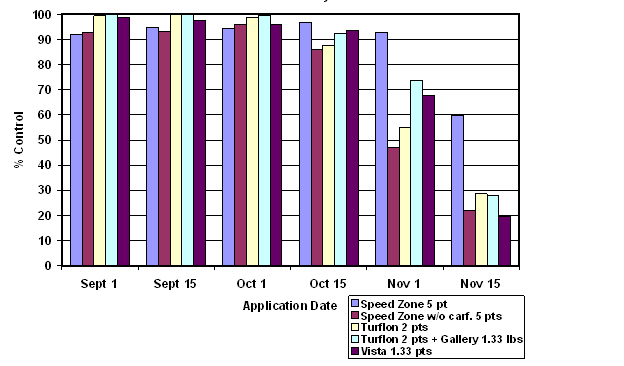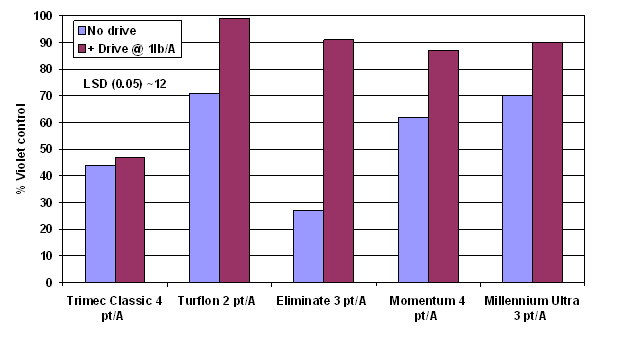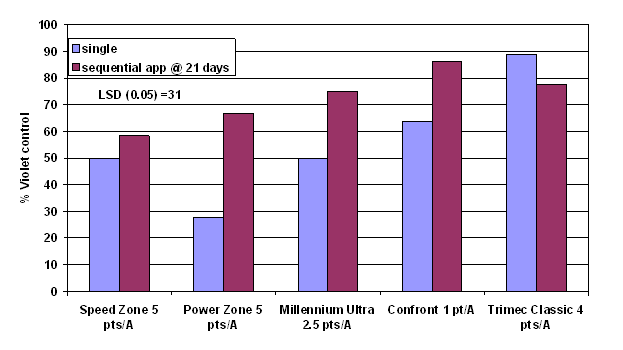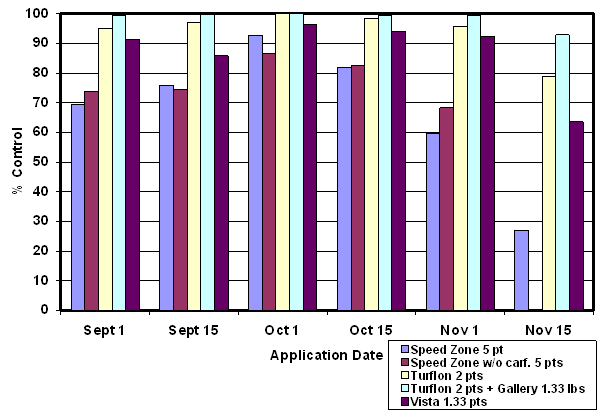As lawns start to thin from summer heat, ground ivy and violets begin to overtake the turf especially insahded areas. These two weeds remain tough to control in Indiana. Even though applications now can produce visible damage, long-term control does not compare to fall applications. We have been working on ground ivy for a number of years years and I suspect much of it would apply to violets and other tough to control weeds. Following is our recommendation for maximizing control, based on experience and research on ground ivy.
-
Mow at 3” or higher.
-
Remove as much of the shade as possible.
-
Increase fertilizer up to 4.0 lbs N/1000ft2/yr fertilizing primarily in the fall
-
The most effective chemistries include in order:
Triclopyr (Turflon), fluroxpyr (Spotlight), and 2,4-D. Carfentrazone-containing products can give good burn-down, but long-term control is marginal (Figs. 1 and 2). We found isoxaben (Gallery) applied with an effective post-emergence herbicide helps to reduce regrowth of surviving stolons. All of our work has been done on ground ivy and would likely apply to violet. Relatively recent work at Michigan State found control of violet to improve dramatically when quinclorac (Drive 75DF) is mixed at 1 lb product/Acre with the typical postemergence herbicides (Figure 3). This product can be damaging to fine fescue, which is often planted in the shade (where these weeds are most problematic). -
If applications are made now, our research on ground ivy and Iowa States work on violets shows a second application in 3-4 weeks should improve control (Fig. 4)
-
Plan on an application in the fall with most effective control coming from mid-Sept to mid-Oct. applications. We have seen almost 100% control of ground ivy by the following June with applications of triclopyr at this time of year (Fig. 2).
-
Populations of ground ivy exist that have differential susceptibility to herbicides. For instance, one population may not be sensitive to 2,4-D while a neighboring population is extremely sensitive to 2,4-D. Therefore, it is important to alternate herbicides when attempting control of ground ivy and maybe violet.
Since ground ivy spreads by stolons and violets by rootstalks and rhizomes, both of these weeds are almost impossible to control with a single year of cultural practices and herbicide applications. Multiple years of a comprehensive control program will likely be needed.

Figure 1. Ground ivy control rated in December from various herbicides applied in September through November. Data are averaged over four years (Purdue 2007).
Figure 2. Ground ivy control rated in June from various herbicides applied in September through November. Data are averaged over four years (Purdue 2007).

Figure 3. Calhoun, R. 2002. Tough Weeds in Michigan: Management options. 72nd Annual Michigan Turfgrass Conference Proceedings. 31: p. 95-97. http://www.lib.msu.edu/turf/mtc2001/106.pdf

